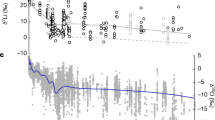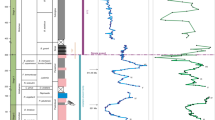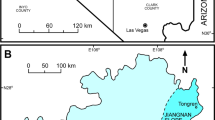Abstract
THE correlation between the oxygen isotope stratigraphy of the oceans and continental stratigraphic records is one of the main challenges for Quaternary research. Most continental classifications, however, are based on techniques and hypotheses that predate recent advances. Nevertheless, the deep-sea oxygen isotope global stratigraphic framework has been extended to the continents by means of some long sequences1; but these are exceptional and regional geology is unsatisfactorily classified for correlation with the oxygen isotope signal. Because successive geological events produced similar evidence (homotaxis), geochronometric dating is essential for correlation, but available methods are highly site-, regional- or sample-specific. Fortunately non-marine molluscs are ubiquitous in time and space, and here we use the time-dependent epimerization of L-isoleucine in these fossils to subdivide the Pleistocene of the British Isles, and to identify more events than recognized by the existing classification2. By calibrating the relative aminostratigraphic scale with independent dating methods we have set up a geochronology which is the basis for land—sea correlations back to oxygen isotope stage 15.
This is a preview of subscription content, access via your institution
Access options
Subscribe to this journal
Receive 51 print issues and online access
$199.00 per year
only $3.90 per issue
Buy this article
- Purchase on Springer Link
- Instant access to full article PDF
Prices may be subject to local taxes which are calculated during checkout
Similar content being viewed by others
References
Guiot, J., Pons, A., de Beaulieu, J. L. & Reille, M. Nature 338, 309–313 (1989).
Mitchell, G. F., Penny, L. F., Shotton, F. W. & West, R. G. Spec. Rep. geol. Soc. Lond. No. 4 (1973).
Bowen, D. Q. Quaternary Geology (Pergamon, Oxford, 1978).
Bowen, D. Q. et al. Quat. Sci. Rev. 4, 279–318 (1985).
Bowen, D. Q. & Sykes, G. A. Phil. Trans. R. Soc. B318, 619–635 (1988).
Muller, P. J. Meteor Forsch.-Eroebnisse 38, 25–47 (1984).
Shotton, F. W. Quat. Newsl. 50, 30 (1986).
Conway, B. W. & Waechter, J. de A. in X INQUA Congress Guidebook for Excursion 5 (eds Sbephard-Thorn, R. & Wymer, J. J.) 38–44 (Geoabstracts, Norwich, 1977).
Briggs, D. J., Gilbertson, D. D. & Coope, G. R. Br. Arch. Ser. 137, 108–139 (1985).
Coope, G. R., Shotton, F. W. & Strachan, I. Phil. Trans. R. Soc. B244, 379–421 (1961).
Kerney, M. P. Proc. geol. Ass. 82, 1–12 (1971).
Hughes, S. A. thesis, Univ. of Wales (1987).
Stringer, C. B., Currant, A. P., Schwarcz, H. P. & Colcutt, S. N. Nature 320, 59–62 (1986).
Holyoak, D. T. & Preece, R. C. Phil. Trans. R. Soc. B311, 193–263 (1985).
Grun, R., Chadam, J. & Schwarcz, H. P. Nucl. Tracks 14, 237–241 (1988).
Martinson, D. G. et al. Quat. Res. 27, 1–29 (1987).
Imbrie, J. et al. in Milankovitch and Climate Part I (eds Berger, A. L. et al.) 269–305 (Reidel, Dordrecht, 1984).
Wehmiller, J. F. Quat. Sci. Rev. 1, 83–120 (1982).
Coope, G. R., Morgan, A. & Morgan, A. V. Palaeogeogr. Palaeoclimatol. Palaeoecol. 10, 87–101 (1971).
Behre, K.-E. Quat. Sci. Rev. 8, 25–44 (1989).
West, R. G. Phil. Trans. R. Soc. B241, 1–31 (1957).
Maddy, D. thesis, Univ. of London (1989).
Sparks, B. W. & West, R. G. Proc. geol. Ass. 74, 419–432 (1963).
Stinton, F. Proc. geol. Ass. 96, 199–215 (1985).
West, R. G. Phil. Trans. R. Soc. B239, 265–356 (1956).
Sparks, B. W., West, R. G., Williams, R. B. G. & Ransom, C. Proc. geol. Ass. 80, 243–267 (1969).
Horton, A. in Field Guide to the East Midlands (ed. Douglas, T. D.) 29–32 (Quaternary Research Association, Cambridge, 1981).
West, R. G. Proc. geol. Ass. 80, 271–282 (1969).
Shotton, F. W., Briggs, D. J., Goudie, A. S. & Osmaston, H. Phil. Trans. R. Soc. B289, 55–86 (1980).
West, R. G. The Preglacial Pleistocene of the Norfolk and Suffolk Coasts (Cambridge University Press, 1980).
Andrews, J. T., Gilbertson, D. D. & Hawkins, A. B. J. geol. Soc. Lond. 141, 967–974 (1984).
Author information
Authors and Affiliations
Rights and permissions
About this article
Cite this article
Bowen, D., Hughes, S., Sykes, G. et al. Land-sea correlations in the Pleistocene based on isoleucine epimerization in non-marine molluscs. Nature 340, 49–51 (1989). https://doi.org/10.1038/340049a0
Received:
Accepted:
Issue Date:
DOI: https://doi.org/10.1038/340049a0
This article is cited by
-
A chronological framework for the British Quaternary based on Bithynia opercula
Nature (2011)
-
How old is ‘Boxgrove man’?
Nature (1994)
Comments
By submitting a comment you agree to abide by our Terms and Community Guidelines. If you find something abusive or that does not comply with our terms or guidelines please flag it as inappropriate.



